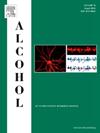Alcohol diminishes barrier integrity in human stem cell-derived brain microvascular endothelial cells: Role of reactive oxygen species
IF 2.9
4区 医学
Q3 PHARMACOLOGY & PHARMACY
引用次数: 0
Abstract
The World Health Organization has linked alcohol consumption to over 200 diseases including neurodegenerative diseases. A dysfunctional blood–brain barrier (BBB) has been found to be influential in a number of brain disorders. The BBB is critical in maintaining homeostasis between the brain vasculature and parenchyma and a loss in barrier integrity would enable otherwise impermeable immune cells, molecules, and inflammatory mediators to reach the brain parenchyma. A subset of studies demonstrated that alcohol could diminish BBB integrity, but it is unclear if this effect translates clinically. In this study, we utilize a human stem cell-derived BBB model with near in vivo properties to investigate the effects of alcohol on critical barrier properties. Barrier forming brain-like microvascular endothelial cells (BMECs) were derived from human induced pluripotent stem cells (iPSCs) and exposed to several alcohol concentrations. Alcohol decreased barrier integrity observed by a loss in trans-endothelial electrical resistance and an increase in sodium fluorescein permeability. Alcohol decreased expression and junctional localization of tight junction proteins, a critical component to barrier integrity. Additionally, alcohol did not affect efflux transporter activity or cell viability in BMECs. The detrimental effects of alcohol on BBB properties were due to in part elevated reactive oxygen species (ROS); as scavenging ROS improved barrier properties, including the restoration of tight junction expression and localization. These data suggest that excessive alcohol consumption could diminish the BBB and contribute to the development or exacerbation of brain disorders.
Clinical trial number and registry URL
Not applicable.
酒精降低人干细胞来源的脑微血管内皮细胞屏障完整性:活性氧的作用
世界卫生组织将饮酒与200多种疾病联系起来,其中包括神经退行性疾病。血脑屏障功能障碍(BBB)已被发现对许多脑部疾病有影响。血脑屏障在维持脑血管和脑实质之间的稳态中起着至关重要的作用,屏障完整性的丧失将使原本不可渗透的免疫细胞、分子和炎症介质能够到达脑实质。一部分研究表明,酒精可以降低血脑屏障的完整性,但尚不清楚这种影响是否在临床上转化。在这项研究中,我们利用具有接近体内特性的人类干细胞衍生血脑屏障模型来研究酒精对关键屏障特性的影响。形成屏障的脑样微血管内皮细胞(BMECs)来源于人诱导多能干细胞(iPSCs),并暴露于几种浓度的酒精中。酒精降低屏障完整性,观察到跨内皮电阻的损失和荧光素钠通透性的增加。酒精降低了紧密连接蛋白的表达和连接定位,紧密连接蛋白是屏障完整性的关键组成部分。此外,酒精不影响bmec的外排转运蛋白活性或细胞活力。酒精对血脑屏障性能的有害影响部分是由于活性氧(ROS)的升高;清除活性氧可以改善屏障特性,包括恢复紧密连接的表达和定位。这些数据表明,过量饮酒可能会减少血脑屏障,导致大脑疾病的发展或恶化。临床试验编号和注册地址:不适用。
本文章由计算机程序翻译,如有差异,请以英文原文为准。
求助全文
约1分钟内获得全文
求助全文
来源期刊

Alcohol
医学-毒理学
CiteScore
4.60
自引率
4.30%
发文量
74
审稿时长
15.6 weeks
期刊介绍:
Alcohol is an international, peer-reviewed journal that is devoted to publishing multi-disciplinary biomedical research on all aspects of the actions or effects of alcohol on the nervous system or on other organ systems. Emphasis is given to studies into the causes and consequences of alcohol abuse and alcoholism, and biomedical aspects of diagnosis, etiology, treatment or prevention of alcohol-related health effects.
Intended for both research scientists and practicing clinicians, the journal publishes original research on the neurobiological, neurobehavioral, and pathophysiological processes associated with alcohol drinking, alcohol abuse, alcohol-seeking behavior, tolerance, dependence, withdrawal, protracted abstinence, and relapse. In addition, the journal reports studies on the effects alcohol on brain mechanisms of neuroplasticity over the life span, biological factors associated with adolescent alcohol abuse, pharmacotherapeutic strategies in the treatment of alcoholism, biological and biochemical markers of alcohol abuse and alcoholism, pathological effects of uncontrolled drinking, biomedical and molecular factors in the effects on liver, immune system, and other organ systems, and biomedical aspects of fetal alcohol spectrum disorder including mechanisms of damage, diagnosis and early detection, treatment, and prevention. Articles are published from all levels of biomedical inquiry, including the following: molecular and cellular studies of alcohol''s actions in vitro and in vivo; animal model studies of genetic, pharmacological, behavioral, developmental or pathophysiological aspects of alcohol; human studies of genetic, behavioral, cognitive, neuroimaging, or pathological aspects of alcohol drinking; clinical studies of diagnosis (including dual diagnosis), treatment, prevention, and epidemiology. The journal will publish 9 issues per year; the accepted abbreviation for Alcohol for bibliographic citation is Alcohol.
 求助内容:
求助内容: 应助结果提醒方式:
应助结果提醒方式:


